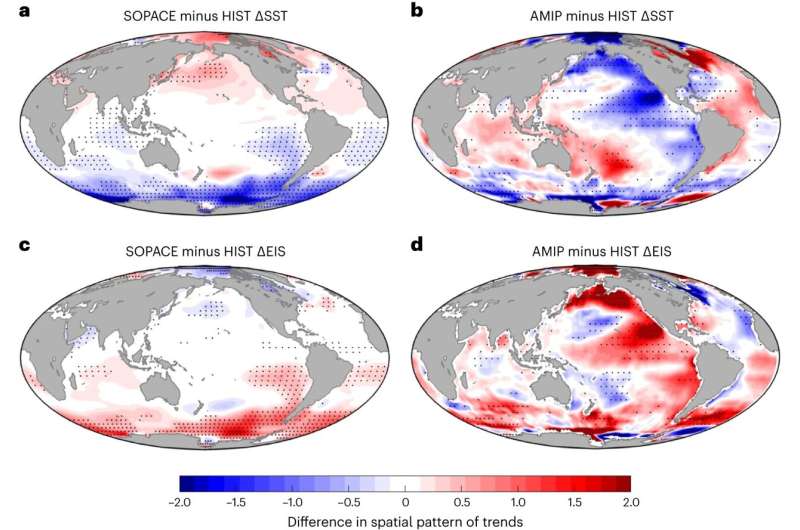This article has been reviewed according to Science X's editorial process and policies. Editors have highlighted the following attributes while ensuring the content's credibility:
fact-checked
peer-reviewed publication
trusted source
proofread
How the Southern Ocean controls global climate feedbacks

The Southern Ocean: How does this body of water and its relationship with clouds contribute to the world's changing climate?
Located at the southernmost end of Earth, the Southern Ocean surrounds Antarctica like a gigantic ring. Its currents flow around the continent in enormous spirals, pushing large amounts of cold water into the other oceans. Despite being remote, the Southern Ocean has an impact on the other oceans and their cloud cover, with effects even in distant tropical locations. Therefore, it is of importance for climate projections.
Between 1979 and 2013, the Southern Ocean surface cooled substantially in observations, and the tropical Pacific has been cooling particularly in the eastern basin at the same time. Both happened despite global warming. However, current coupled climate models fail to simulate the observed pattern and its associated anomalous enhanced tropical cloud cover during that period, which acted like a sunscreen to slow down global warming.
While the Southern Ocean cooling is often attributed to a La Niña–like Pacific sea surface temperature trend, the authors propose an alternative hypothesis in their study: that the observed Southern Ocean cooling may have partially contributed to more negative global climate feedbacks. That means that the cooling of the Southern Ocean sparked a favorable chain of events that lessened the severity of warming due to climate change.
The study is published in the journal Nature Geoscience.
Eliciting secrets from ocean and clouds
The authors show that accounting for the recent Southern Ocean cooling, which is absent in coupled climate models so far, leads to a better representation of clouds and how they react to warming in climate models. It results in halving the model error in the global climate feedback, a measure of how clouds and other processes amplify or dampen global warming. This finding highlights the important role of the Southern Ocean in controlling the temporal evolution of the global feedback.
Prof. Kang and her colleagues use a climate model experiment in which Southern Ocean sea surface temperatures are restored to observations. They find that the Southern Ocean cooling leads to a remote cooling in the southeastern tropical Pacific, which, in turn, allows for a more precise representation of clouds in the simulation: in line with satellite observations, the experiment with Southern Ocean cooling simulates a strong increase in stratocumulus cloud cover.
How to fix the bias and find out where we are headed to
The scientists propose that the reaction of the subtropical stratocumulus clouds is too weak in the majority of coupled climate models, thereby underestimating the Southern Ocean-driven effects in distant regions and the associated influence on global feedbacks. The study therefore highlights the need for improving the model simulation of low clouds to properly represent the pathways of the remote effects and links, which ultimately controls the temporal evolution of the global climate feedback.
Addressing this bias is of particular interest because it may shift our estimate of the climate sensitivity, a key measure of how much our climate will change as greenhouse gas emissions increase, to higher values than currently simulated as the Southern Ocean undergoes accelerated warming in future projections.
More information: Kang, S.M. et al, Recent global climate feedback controlled by Southern Ocean cooling, Nature Geoscience (2023). DOI: 10.1038/s41561-023-01256-6. www.nature.com/articles/s41561-023-01256-6
Journal information: Nature Geoscience
Provided by Max Planck Society




















